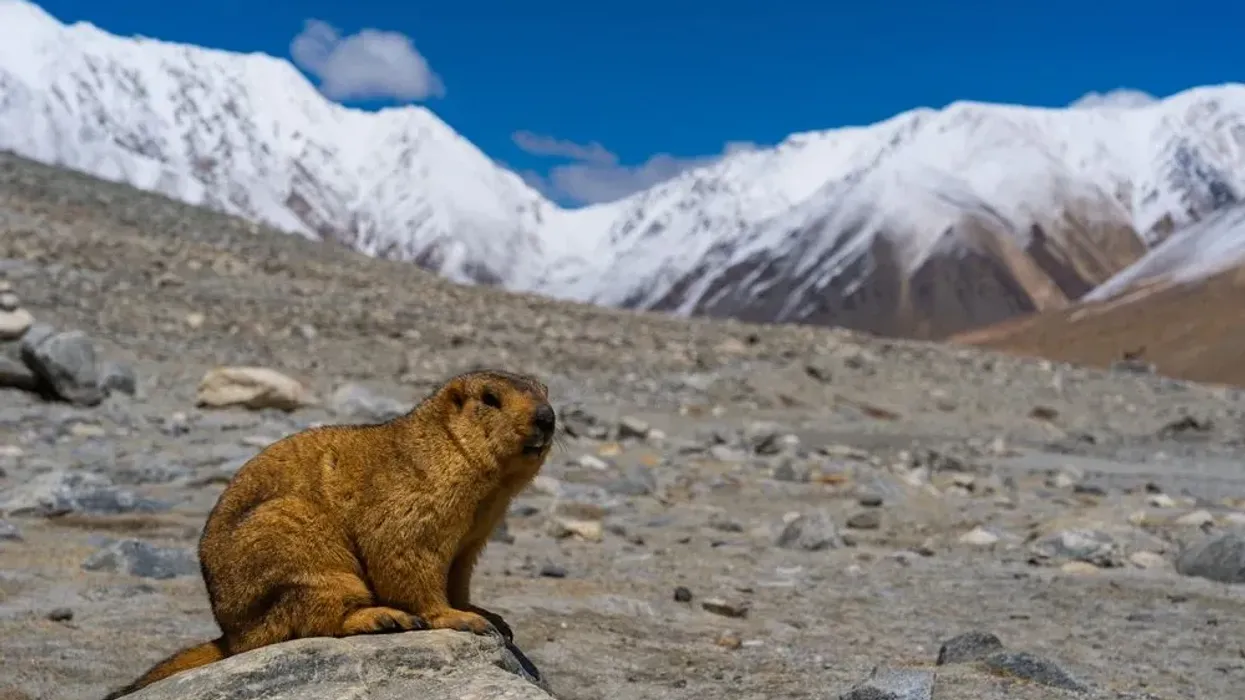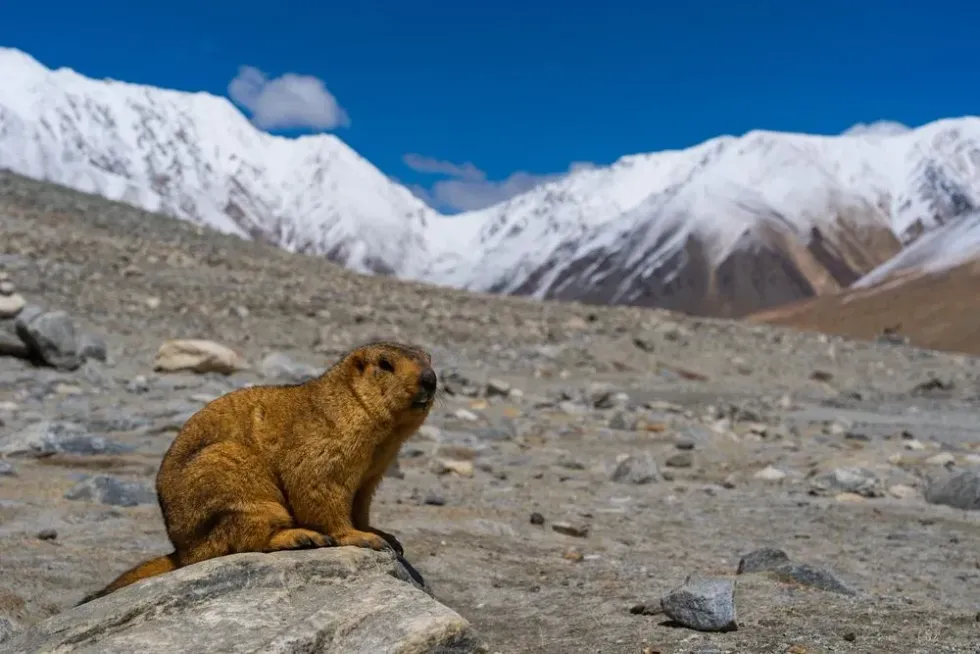There exist a total of 14 species of marmots. The Himalayan marmot (Marmota himalayana) is a family member of the same set of species.
Marmots are wild animals and are highly sociable in nature. They communicate using large whistles and feed primarily on grasses, berries, roots, and flowers and in some instances, feed on insects and birds' eggs as well.
These species are one of the highest living mammals in the world. The Himalayan marmots are far more common as compared to other species of marmots.
They primarily are seen near Ganda la, Ladakh, Nepal as well as areas located in and around the Himalayas.
The ecological niche of the Himalayan marmots includes firstly, them being primarily diet for snow leopards, secondly, helping increase soil aeration through burrowing throughout their range, and lastly, they provide a good habitat to semi fossorial or fossorial type species. Read on to discover all about the fascinating Himalayan marmots.
If you like this article, take a look at nutria and prairie dog fact articles too.
Himalayan Marmot Interesting Facts
What type of animal is a Himalayan marmot?
The Marmot (Marmota himalayana) Hodgson is a marmot animal and belongs to the kingdom Animalia.
What class of animal does a Himalayan marmot belong to?
The Himalayan marmot (Marmota) belongs to the Mammalia class of species and the Sciuridae family and genus Marmota.
How many Himalayan marmots are there in the world?
There exist a total of 14 species of marmots. The exact population of the same is not evaluated however they are a Least Concern species on the red list of threatened species.
Where does a Himalayan marmot live?
Himalayan marmot species inhabit alpine grasslands located near-polar regions located in and around the Himalayan regions as well as deserts and some parts of east and south Asia countries like China, India, Nepal, and Pakistan. Recently the mechanisms of their adaptation to high altitude have been of great interest.
What is a Himalayan marmot's habitat?
They are found between timberline and snowline areas at elevations of 3,500-5,200m. They prefer dry, and open habitats including alpine grasslands and desserts. They also prefer regions with proper vegetation to feed on and where they can dig out deep burrows for themselves to reside in. Marmots are found 4000m to the upper edge of the vegetated zone.
Who do Himalayan marmots live with?
They reside on their own as well as in marmot colonies. Burrows made in soil are shared by all members of their colony. These species are seldom seen near humans since they inhabit regions near high altitude regions.
How long does a Himalayan marmot live?
The average lifespan for a marmot species is 12-17 years in age. The maximum age Himalayan marmots have lived is up to 18 years in age. This depends on various other factors like their diet and their environment as well.
How do they reproduce?
They are largely monogamous however, some females do mate with multiple mates throughout their lifetime. Annual mating occurs in the months of February and March. They reach reproductive age by the age of two years.
The gestation period lasts up to one month. Marmots who give birth early experience a lot of stress. Pregnant females gain weight by three weeks and give birth to a minimum of four offsprings per litter. They are closely dependant on adults for up to 15 days to a month.
They also employ alloparental care where unrelated adults take care of the offspring. Once the offsprings are independent. The juveniles maintain permanent residences in their familial communities typical of most marmots.
What is their conservation status?
Marmots (Marmota) have been identified as a Least Concern species by the International Union For Conservation Of Nature (IUCN) red list of threatened species. Himalayan marmots contribute towards maintaining higher plant diversity and influence soil formulation processes, and so are important to the ecosystem.
Himalayan Marmot Fun Facts
What do Himalayan marmots look like?
To put it simply, the Himalayan marmot looks like large ground squirrels i.e. they are relatively short furred. They are Rufous gray, with dark chocolate brown coats and contrasting yellow patches. They are largely yellow-bellied.
Each of their forefeet has four toes with long concave claws for burrowing each hind foot has five toes. They are long-tailed measuring 125-150 mm. Their head is flat with triangular and black eyes, long whiskers, and small rounded ears. Their ear length is from 23-30 mm.

How cute are they?
Himalayan marmots exhibit seasonal variation in behavior. Hibernation extends for longer periods and they share their burrows with other members of the colony. Hibernation is the period of dormancy. They are cute animals but might harm you if you invade their territory. They are primarily designed for burrowing lifestyle or behavior and specialized for digging.
How do they communicate?
They socialize through greeting behavior that consists of the nose to nose, nose to mouth, and other forms of communication. Himalayan marmots also make use of whistling and chirping to communicate.
They are highly alert animals and react immediately if they sense the presence of both predators and prey. When they sense predators they produce a series of alarm calls. Apart from this they also communicate when with possible mates through the use of pheromones.
How big is a Himalayan marmot?
The Himalayan marmot is 18i-26 in (45-67 cm) long which is five times bigger than the smallest species of marmots which is the Menzbier's marmot and is 13.6-19.7 in (34.5-50 cm).
How fast can a Himalayan marmot run?
Average marmots run at speeds of 3 m/s. They don't run unless they are in a position of threat in which case they run as fast as possible to reach their burrows. If they are not near their burrows they usually run into burrows made by other mates in their colonies.
How much does a Himalayan marmot weigh?
Himalayan marmots weigh 8.8-20.3 lb (4-9.2 kg). The largest species of marmots are the Olympic marmots that can weigh up to 18 lb.
What are their male and female names of the species?
Male and female species are not addressed differently. There are differences in size which help identify the same. Males tend to be heavier than females they also have different reproductive functions.
What would you call a baby Himalayan marmot?
A baby Himalayan marmot is referred to as a pup. Baby Himalayan marmots are born without fur and are small in size as compared to adult species.
They attain maturity at the age of two years when they grow up in size and shape as well. Baby Himalayan marmots live in burrows until they are ready to leave them and live independently.
What do they eat?
They primarily consume food of a vegetative diet and are herbivores. The Himalayan marmot diet consists of feed primarily on plants, grasses, berries, roots, and flowers, and if they don't find that, they search for alternative sources of food including smaller insects or even bird eggs.
Their food habits adapt as per the seasonal changes. Their predators include wolves, fox, hawks, and vultures. They also drink water from time to time.
Are they dangerous?
They are relatively less dangerous as compared to other wild animals however they do have sharp nails and teeth to bite and hence it's best to maintain a distance if you ever spot one. They are carriers of diseases like Lyme disease, rocky mountain, or spotted fever.
They are also transmitters of hantavirus and rabies in some instances so it's best to maintain a safe distance from them.
Would they make a good pet?
No, the Himalayan marmot (Marmota himalayana) is an innately wild animal, and plus they can lead to damage of property in many instances. They survive best in their natural habitats where they survive eating plants growing on pastures.
They are transferred illegally in many instances. They are seen alone as well as in colonies.
They are seen in large numbers in and around their natural habitat where their population densities are more. Animals like squirrels who they are closely compared to are adopted as pets by various people and more commonly seen as compared to marmots.
Did you know...
The Himalayan marmot is one of the highest living mammals in the world. Himalayan marmots are found largely in their natural habitats of a high altitude. They are important prey for a number of other predatory mammals and birds.
It is illegal to own a marmot in the United States since they are considered wild animals plus they don't make good companions. Their teeth grow constantly making them desire to chew on things more. This could lead to excessive destruction if kept as a pet.
Records and information on these species of animals exist in the Stanford University Press as well as other press like the popular John Hopkins University Press. W.C. Wozencraft's 'A guide to the mammals of China', Princeton University Press 2010, includes an in-depth analysis of the marmot species.
Recently, the mechanisms of their adaptation to high altitude have been of great interest.
Marmots have been eaten in Mongolian cultures as a delicacy. The dish made is called boodog. The meat is cooked by inserting hot stones, preheated in fire, into the abdominal cavity of a deboned animal.
The skin is later tied up to make a bag within which the meat cooks. It is said that marmot meat tastes similar to wild duck. It is illegal to hunt marmots in Russia.
Where do marmots sleep?
They usually sleep in burrows which they make and are rarely seen resting out in the open. Resting out in the open would mean that they would be easily identifiable by possible predators.
They are less active during night hours and since they feed on plants and vegetation of different kinds it's best for them to stay active throughout the day. They live in alpine grasslands and areas in and around the Himalayan mountains.
Do marmots have long tails?
They are long-tailed measuring 125-150 mm, however, compared to their body length it's relatively short. They use their tails for locomotion.
Marmots are often confused with woodchucks native to New York who are one popular species of marmots that are considered to be a larger species of the squirrel and part of the marmot family of species.
Another species marmots are often confused with is the ferret who are primarily carnivores and do not belong to the same family of marmots.
Marmots are closely associated in familiarity with squirrels also known by their scientific name Rodentia sciuridae.
They are unique and essential for the sustenance of the ecosystem. Since they reside in higher altitudes, it's possible that you seldom see them, however, if you ever see one, make sure to observe them from a distance.
Here at Kidadl, we have carefully created lots of interesting family-friendly animal facts for everyone to discover! Learn more about some other mammals including ferret or woodchuck.
You can even occupy yourself at home by drawing one on our Himalayan Marmot coloring pages.









